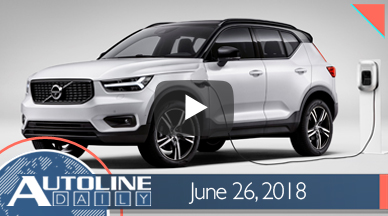
Runtime: 5:51
0:30 MEMA Wants Congress to Take Action on Trade
1:12 Mercedes Makes Room for EQ Brand
2:13 Volvo Predicts Shorter Range EVs
2:57 Pratt & Miller Develops Extreme Travel Suspension
4:10 Consortium Works to Make Standard for Digital Keys
4:56 Next-Gen Chevrolet Malibu Details
Visit our sponsors to thank them for their support of Autoline Daily: Bridgestone , Dow Automotive Systems , Lear Corporation , and ExxonMobil.
On today’s show… MEMA wants Congress to stop Trump’s trade war… Volvo predicts that EVs will soon have shorter driving ranges, not longer ones… and the day is coming when we’ll all start our cars with smart phones. All that and more coming right up on Autoline Daily.
This is Autoline Daily the show for enthusiasts of the automotive industry.
MEMA AND TRADE ASSOCIATIONS SLAM TRUMP TRADE
The Motor Equipment and Manufacturers Association or MEMA, wants Congress to stop President Trump’s trade war. The Association, which lobbies for vehicle manufacturers and suppliers, sent a letter to leaders in Congress lamenting the lack of Congressional oversight over American trade policy. MEMA cites the Constitutional directive that gives Congress the power to regulate foreign trade. It doesn’t call for specific action, but wants hearings on whether Congress has delegated too much power to the President on trade. While Trump says higher tariffs are needed to protect the auto industry, the industry doesn’t quite see it that way.
MERCEDES MAKES ROOM FOR EQ
Mercedes is stopping sales of the plug-in hybrid versions of the C, E, and S-Class, as well as all GLE models in the U.K. to make room for its next-generation of electrified models that will be sold under the EQ brand. The new PHEV system features a nine-speed automatic with an integrated electric motor that can be bolted up to different kinds of engines. That makes converting a car to a PHEV a lot easier. But this makes us wonder if Mercedes will make the same move in other markets as it launches the EQ brand?
Volvo says electric cars will soon have shorter driving ranges and we’ll explain why after this.
VOLVO PREDICTS SHORTER RANGE EVs
Volvo predicts that we’re soon going to see electric cars with shorter driving ranges, not longer ones. Volvo’s head of R&D, Henrik Green, says people have range anxiety today because there are not enough public fast-charging stations. That’s why they want EVs with longer range. He says once fast-charging stations become common, car buyers will wonder why they’re spending so much money on bigger batteries and lugging all that extra weight around all the time. He says a 50 kilowatt-hour battery will be ideal. That would provide around 200 miles of range. Henrik Green says EV owners do 95% of their charging at home so they start out every morning with their maximum range available.
SUSPENSION TRAVEL, TO THE EXTREME!
In the past, making a military vehicle safer meant slapping on more armor. But the Defense Advanced Research Projects Agency or DARPA has a program that aims to improve survivability without adding more armor. Part of that initiative includes an extreme travel suspension system developed by Pratt & Miller. And when I say extreme, I mean extreme. It’s able to move 42-inches up and 30-inches down for a total of 6-feet of travel. This would allow vehicles to travel at high rates of speed over rough terrain, without roughing the passengers up too much or drive on the side of a steep hill without fear of tipping over. And it’s pretty amazing how the cab of the vehicle barely seems to move.
Coming up next, the day is fast coming when car keys will be a thing of the past.
CALLING ALL CARS
In the old days you had to start your car with a hand crank. Later on, all you had to do was turn a key. Most cars today allow you to push a button on the dashboard. But in the not too distant future we’ll all be starting cars with our phones. The Car Connectivity Consortium, or CCC, is working on a standard for all phones and all cars. You’ll even be able to transfer the key to another driver which the CCC says will be handy for car sharing. There’s even the possibility of storing custom driver settings in this “digital key,” so the car is set to your preferences as soon as you get in. Our only question is, which do you lose more often, your car keys or your phone?
NEXT-GEN CHEVROLET MALIBU
While Ford is just about giving up selling passenger cars in the US market, General Motors is clearly committed to making them. AutoForecast Solutions reports that the next generation Chevrolet Malibu will go into production in August, 2022. It will be made at GM’s Fairfax assembly plant in Kansas, which is where the current model is made.
Don’t forget to join us for Autoline After Hours this Thursday as we take you on a deep dive into the all-new Volkswagen Jetta. Join john and Gary for some of the best insights as to how new cars get developed.
And that wraps up today’s show, thanks for watching and please join us again tomorrow.
Thanks to our partner for embedding Autoline Daily on its website: WardsAuto.com

John McElroy is an influential thought leader in the automotive industry. He is a journalist, lecturer, commentator and entrepreneur. He created “Autoline Daily,” the first industry webcast of industry news and analysis.




